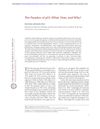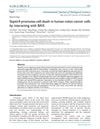Search
forLearn
5 / 5 resultslearn Osteopontin
signaling protein that, when suppressed, may grow hair by reducing inflammation and stem cell loss
learn Vascular Endothelial Growth Factor
learn sh-Polypeptide-7
learn Neem Oil
natural substance from Neem tree with medicinal and pesticidal properties
Research
5 / 1000+ results
research Antiviral Drugs Prolong Survival in Murine Recessive Dystrophic Epidermolysis Bullosa
Antiviral drugs, especially daclatasvir, may be a new treatment for a rare skin disease, improving survival and reducing symptoms in mice.

research The Paradox of p53: What, How, and Why?
The p53 protein has complex, sometimes contradictory functions, including tumor suppression and promoting cell survival.
research Apoptotic Cells May Drive Cell Death in Hair Follicles During Their Regression Cycle
Apoptotic cells may trigger cell death in hair follicles during their regression cycle.
research Editor's Evaluation: Role of Distinct Fibroblast Lineages and Immune Cells in Dermal Repair Following UV Radiation-Induced Tissue Damage
Different types of sun exposure damage skin cells and immune cells, with chronic exposure leading to more severe and lasting damage.

research Septin4 Promotes Cell Death in Human Colon Cancer Cells by Interacting with BAX
Septin4 helps kill colon cancer cells by working with the protein BAX.
Community Join
5 / 347 resultscommunity New Research- Creatine Increasing Scalp DHT Without Corresponding Serum DHT Increase
Creatine may increase scalp DHT without affecting serum DHT, potentially speeding up male pattern baldness (MPB) for those genetically prone. Treatments mentioned include Minoxidil, finasteride, and RU58841.
community 3 hair transplants + finasteride + minoxidil (full review)
A user shared their experience with three hair transplants, finasteride, and minoxidil to combat severe hair loss, achieving significant regrowth. They discussed the process, costs, and maintenance, emphasizing that transplanted hair is permanent and doesn't require ongoing medication.
community How ET-02 Works. Also no proof that it's better than Minoxidil. At least for now.
ET-02, a PAI-1 inhibitor, is not proven to be more effective than Minoxidil for hair loss. Other treatments like finasteride, dutasteride, PP405, and AMP-303 are also discussed, focusing on cellular senescence and oxidative stress.
community Female, 30, PCOS diagnosis, MPB Norwood 2. Endo refuses to give anything other than Spironolactone. Feel like I’m at my wit’s end here.
A 30-year-old female with PCOS and male pattern baldness is frustrated with her endocrinologist's recommendation of only Spironolactone and minoxidil, feeling that dutasteride, finasteride, and progesterone would be more effective. Other users suggest various online sources for treatments, warn against self-medicating due to potential risks, and recommend seeking a specialized endocrinologist or considering additional treatments like Inositol, Berberine, and dermaneedling.

community Compressed part of research of theory of androgenic/anabolitic balance. AGA h-responders analytic. Theory of physio-metabolitic method of anti AGA treatment
The treatment for androgenetic alopecia involves using finasteride and minoxidil with intense exercise and cold exposure to boost metabolism and reduce androgenic effects, potentially leading to hair regrowth. This approach may activate biological pathways for improved hair and overall health.